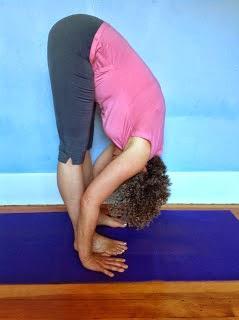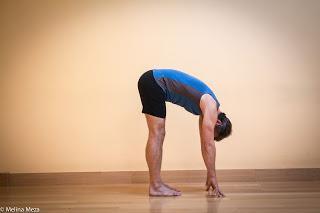by Baxter
 As you can see from these photos, anyone observing Nina and me practice Standing Forward Bend (Uttanasana) would immediately see that even though we’re both long-time practitioners, our ability to stretch the muscles in the backs of our legs varies greatly. Yes, it turns out that flexibility among people varies, and often quite a bit! Some people are naturally tight, some are naturally flexible, and others are overly flexible.
As you can see from these photos, anyone observing Nina and me practice Standing Forward Bend (Uttanasana) would immediately see that even though we’re both long-time practitioners, our ability to stretch the muscles in the backs of our legs varies greatly. Yes, it turns out that flexibility among people varies, and often quite a bit! Some people are naturally tight, some are naturally flexible, and others are overly flexible. There are three factors that influence our flexibility:
- Joint stabilizing structures of the joint capsule and ligaments might have more or less flexibility. (You might detect this by sensing limitation or restrictions near to your joints.)
- Muscle length or fascial tightness. (You might detect this by sensing the limitation or restriction mid-muscle or along the length of a muscle group.)
- Disease processes that affect flexibility, like generalized arthritis or Parkinson’s disease, which can gradually decrease flexibility over the long haul. Certain rare conditions can have more extreme effects on flexibility, such as Ehler-Danlos Syndrome, which makes people hyper-mobile and scleroderma, which makes people severely restricted.
When you practice for flexibility, you should take all of these factors into consideration. If you’re naturally tight or have average flexibility, we recommend you begin with dynamic poses to warm up and release your overnight tightness, and then practice static stretches that you hold for least 90 seconds, if possible, to increase your chances of increasing your resting muscle length and improving your range of motion. If you are overly flexible, attempting to become more flexible may actually be dangerous, as you risk of worsening the lax support your joints already have. So even though being more flexible would enable to do super bendy poses with greater ease, we recommend that you focus on strength instead. Include more strengthening poses in your practice, and use isometric contractions around your joints in all your poses (see Why and How to Activate Your Muscles in Yoga Poses), including your stretching poses. Although there is no official standard for “average flexibility” means, you can assess yourself by doing the following basic poses and comparing your range of motion and flexibility with those of fellow practitioners, or have your teacher watch you do them and ask for their feedback assessment: - Standing Forward Bend (Uttanasana)
- Crescent Moon pose
- Triangle pose (Trikonasana)
- Lunge pose (Vanarasana)
- Bridge pose (Setubanda Sarvangasana)
- Cobbler's pose (Baddha Konasana)
- Easy Sitting Twist (Parsva Sukasana)
Beware, however, that just as there is no set standard for “average flexibility” means, that within an individual, flexibility can vary quite a bit from joint to joint. For example, you might be flexible in the shoulders but tight in the hips or vice versa. So be careful not to label yourself as stiff or flexible without a good examination of your flexibility in all areas of your body. In addition, certain medical conditions can temporarily limit flexibility in specific areas of your body, such as frozen shoulder or acute shoulder bursitis, which would limit many of the movements of the shoulder joint. Once you have identified your tight areas, you might want to focus more attention on increasing flexibility those areas. For instance, due to being flexible in the hip muscles that allow me externally rotate my legs, poses such as Cobbler’s pose (Baddha Konasana) and even Lotus pose are fairly easy for me. However, as you can see from the photo above, my hip muscles that allow forward bending (flexion), which is required for Standing Forward Bend are much more restricted. So, it behooves me to spend more time on lengthening the muscles that inhibit forward bending from my hips, rather than focusing on hip stretches for Lotus-like poses that I don’t need more flexibility to achieve. So, when thinking about how you can influence your own flexibility, be sure to take a good look at your body as well as your health history. This will enable you to design a customized practice that will benefit you as an individual and help keep you safe.
Subscribe to Yoga for Healthy Aging by Email ° Follow Yoga for Healthy Aging on Facebook ° Join this site with Google Friend Connect

 As you can see from these photos, anyone observing Nina and me practice Standing Forward Bend (Uttanasana) would immediately see that even though we’re both long-time practitioners, our ability to stretch the muscles in the backs of our legs varies greatly. Yes, it turns out that flexibility among people varies, and often quite a bit! Some people are naturally tight, some are naturally flexible, and others are overly flexible.
As you can see from these photos, anyone observing Nina and me practice Standing Forward Bend (Uttanasana) would immediately see that even though we’re both long-time practitioners, our ability to stretch the muscles in the backs of our legs varies greatly. Yes, it turns out that flexibility among people varies, and often quite a bit! Some people are naturally tight, some are naturally flexible, and others are overly flexible. 
